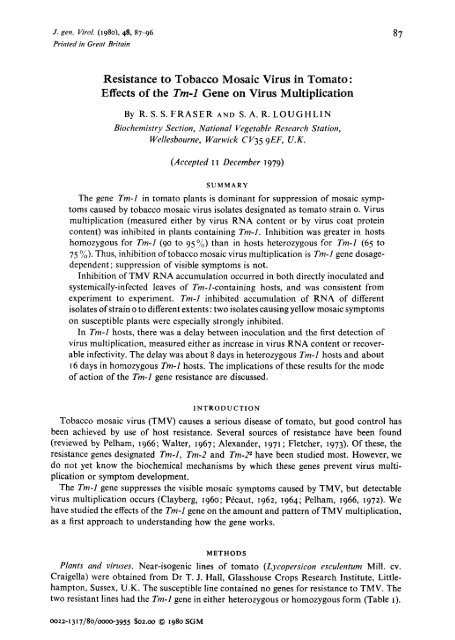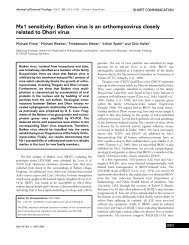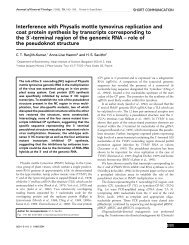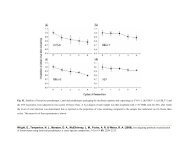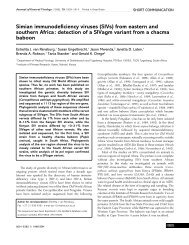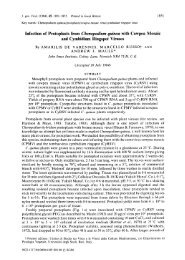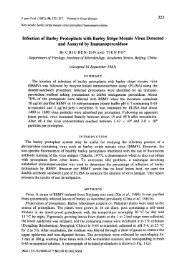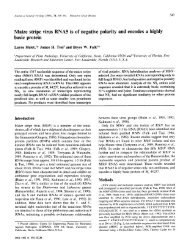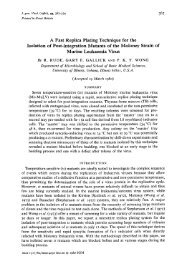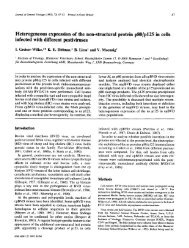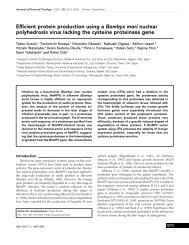Resistance to Tobacco Mosaic Virus in Tomato - Journal of General ...
Resistance to Tobacco Mosaic Virus in Tomato - Journal of General ...
Resistance to Tobacco Mosaic Virus in Tomato - Journal of General ...
Create successful ePaper yourself
Turn your PDF publications into a flip-book with our unique Google optimized e-Paper software.
J. gen. ViraL 0980), 48, 87-96 87<br />
Priated <strong>in</strong> Great Brita<strong>in</strong><br />
<strong>Resistance</strong> <strong>to</strong> <strong>Tobacco</strong> <strong>Mosaic</strong> <strong>Virus</strong> <strong>in</strong> Toma<strong>to</strong>:<br />
Effects <strong>of</strong> the T<strong>in</strong>-1 Gene on <strong>Virus</strong> Multiplication<br />
By R. S. S. FRASER AND S. A. R. LOUGHLIN<br />
Biochemistry Section, National Vegetable Research Station,<br />
Wellesbourne, Warwick CV35 9EF, U.K.<br />
(Accepted I I December ~979)<br />
SUMMARY<br />
The gene T<strong>in</strong>-1 <strong>in</strong> <strong>to</strong>ma<strong>to</strong> plants is dom<strong>in</strong>ant for suppression <strong>of</strong> mosaic symp-<br />
<strong>to</strong>ms caused by <strong>to</strong>bacco mosaic virus isolates designated as <strong>to</strong>ma<strong>to</strong> stra<strong>in</strong> o. <strong>Virus</strong><br />
multiplication (measured either by virus RNA content or by virus coat prote<strong>in</strong><br />
content) was <strong>in</strong>hibited <strong>in</strong> plants conta<strong>in</strong><strong>in</strong>g Tm-l. Inhibition was greater <strong>in</strong> hosts<br />
homozygous for T<strong>in</strong>-1 (90 <strong>to</strong> 95 %) than <strong>in</strong> hosts heterozygous for T<strong>in</strong>-1 (65 <strong>to</strong><br />
75 %). Thus, <strong>in</strong>hibition <strong>of</strong> <strong>to</strong>bacco mosaic virus multiplication is T<strong>in</strong>-1 gene dosage-<br />
dependent; suppression <strong>of</strong> visible symp<strong>to</strong>ms is not.<br />
Inhibition <strong>of</strong> TMV RNA accumulation occurred <strong>in</strong> both directly <strong>in</strong>oculated and<br />
systemically-<strong>in</strong>fected leaves <strong>of</strong> T<strong>in</strong>-l-conta<strong>in</strong><strong>in</strong>g hosts, and was consistent from<br />
experiment <strong>to</strong> experiment. T<strong>in</strong>-1 <strong>in</strong>hibited accumulation <strong>of</strong> RNA <strong>of</strong> different<br />
isolates <strong>of</strong> stra<strong>in</strong> o <strong>to</strong> different extents: two isolates caus<strong>in</strong>g yellow mosaic symp<strong>to</strong>ms<br />
on susceptible plants were especially strongly <strong>in</strong>hibited.<br />
In Tm-I hosts, there was a delay between <strong>in</strong>oculation and the first detection <strong>of</strong><br />
virus multiplication, measured either as <strong>in</strong>crease <strong>in</strong> virus RNA content or recover-<br />
able <strong>in</strong>fectivity. The delay was about 8 days <strong>in</strong> heterozygous Tm-1 hosts and about<br />
t 6 days <strong>in</strong> homozygous T<strong>in</strong>-1 hosts. The implications <strong>of</strong> these results for the mode<br />
<strong>of</strong> action <strong>of</strong> the T<strong>in</strong>-1 gene resistance are discussed.<br />
INTRODUCTION<br />
<strong>Tobacco</strong> mosaic virus (TMV) causes a serious disease <strong>of</strong> <strong>to</strong>ma<strong>to</strong>, but good control has<br />
been achieved by use <strong>of</strong> host resistance. Several sources <strong>of</strong> resistance have been found<br />
(reviewed by Pelham, 1966; Walter, I967; Alexander, 1971; Fletcher, 1973). Of these, the<br />
resistance genes designated Tm-1, T<strong>in</strong>-2 and Tm-22 have been studied most. However, we<br />
do not yet know the biochemical mechanisms by which these genes prevent virus multi-<br />
plication or symp<strong>to</strong>m development.<br />
The T<strong>in</strong>-1 gene suppresses the visible mosaic symp<strong>to</strong>ms caused by TMV, but detectable<br />
virus multiplication occurs (Clayberg, I96O; P&aut, T962, I964; Pelham, I966, I972). We<br />
have studied the effects <strong>of</strong> the Tm-1 gene on the amount and pattern <strong>of</strong> TMV multiplication,<br />
as a first approach <strong>to</strong> understand<strong>in</strong>g how the gene works.<br />
METHODS<br />
Plants and viruses. Near-isogenic l<strong>in</strong>es <strong>of</strong> <strong>to</strong>ma<strong>to</strong> (Lycopersicon esculentum Mill. cv.<br />
Craigella) were obta<strong>in</strong>ed from Dr T. J. Hall, Glasshouse Crops Research Institute, Little-<br />
hamp<strong>to</strong>n, Sussex, U.K. The susceptible l<strong>in</strong>e conta<strong>in</strong>ed no genes for resistance <strong>to</strong> TMV. The<br />
two resistant l<strong>in</strong>es had the T<strong>in</strong>-1 gene <strong>in</strong> either heterozygous or homozygous form (Table I).<br />
OO22-1317/80/0OO0-3955 $02.00 ~) 1980 SGM
88 R.S.S. FRASER AND S.A.R. LOUGHLIN<br />
Table I. Symp<strong>to</strong>ms and changes <strong>in</strong> chlorophyll content result<strong>in</strong>g from <strong>in</strong>fection <strong>of</strong> three<br />
<strong>to</strong>ma<strong>to</strong> l<strong>in</strong>es <strong>of</strong> different TMV-resistant genotypes with TMV stra<strong>in</strong> o*<br />
Symp<strong>to</strong>ms Chlorophyll content (mg/g fresh wt)<br />
produced by , --~ ,<br />
Host l<strong>in</strong>e Genotype TMV <strong>in</strong>fection Healthy TMV-<strong>in</strong>fected<br />
GCR z6 +/+ Systemic mosaic 4"o2+0-02 2"~9+_o'I t<br />
J 484 T<strong>in</strong>-I~ + None 3"74 -+ o.ol 3"55 + o'o8<br />
GCR z37 Tm-1/Tm-1 None 3"53 --+ 0"05 3"59 + o'o I<br />
* Plants were <strong>in</strong>oculated with TMV at a concentration <strong>of</strong> 2 #g/ml. Eighteen days later, symp<strong>to</strong>ms were<br />
observed and chlorophyll concentration determ<strong>in</strong>ed on four replicate samples <strong>of</strong> upper, systemically-<br />
<strong>in</strong>fected leaves. Values are means + standard errors.<br />
The plants were grown <strong>in</strong> I2. 5 cm diam. pots <strong>in</strong> Lev<strong>in</strong>g<strong>to</strong>n compost/sand (3:Q and<br />
transferred <strong>to</strong> larger pots as necessary. Plants were kept <strong>in</strong> a glasshouse at I6 °C at night;<br />
dur<strong>in</strong>g the day the temperature rose <strong>to</strong> between 23 and 3 ° °C, depend<strong>in</strong>g on the season.<br />
Natural light<strong>in</strong>g was supplemented <strong>in</strong> the w<strong>in</strong>ter months with morn<strong>in</strong>g and even<strong>in</strong>g illumi-<br />
nation from mercury vapour lamps giv<strong>in</strong>g an irradiance <strong>of</strong> 5o W/m e. Day length was a<br />
m<strong>in</strong>imum <strong>of</strong> I4 h.<br />
Isolates <strong>of</strong> TMV <strong>to</strong>ma<strong>to</strong> stra<strong>in</strong>s o and ~ (Pelham, I972) and a stra<strong>in</strong> o isolate produc<strong>in</strong>g<br />
yellow symp<strong>to</strong>ms, designated as stra<strong>in</strong> or, were obta<strong>in</strong>ed from Dr Hall, GCRI. The <strong>to</strong>ma<strong>to</strong><br />
stra<strong>in</strong>flavum (Melchers, I94o) and the <strong>to</strong>bacco stra<strong>in</strong> vulgare were orig<strong>in</strong>ally from the Max<br />
Planck Institut for Biologie, Ttib<strong>in</strong>gen, West Germany. All TMV stra<strong>in</strong>s were multiplied <strong>in</strong><br />
<strong>to</strong>bacco (Nicotiana tabacum L. cv. Samsun) and purified by the method <strong>of</strong> Mundry (I957).<br />
Plants <strong>of</strong> uniform height were selected for each experiment; over all experiments the<br />
plants ranged from <strong>to</strong> <strong>to</strong> 3o cm tall at the time <strong>of</strong> <strong>in</strong>oculation. Between 3 and 7 replicate<br />
plants were used for each treatment or host genotype. Plants were <strong>in</strong>oculated on two upper,<br />
expanded leaves by dust<strong>in</strong>g with 4oo-mesh Carborundum and rubb<strong>in</strong>g by hand with a<br />
suspension <strong>of</strong> purified TMV at 2 <strong>to</strong> 5 O/zg/ml <strong>in</strong> 5o raM-sodium phosphate buffer, pH 7.<br />
Leaves were washed with runn<strong>in</strong>g tap water immediately after <strong>in</strong>oculation.<br />
Measurement <strong>of</strong> TM V RNA. At each sampl<strong>in</strong>g time, leaflets were taken from all leaves<br />
<strong>in</strong>oculated for each treatment. Samples were also taken from the 4th and 5th leaves above<br />
the <strong>in</strong>oculated leaves. Midribs were removed and the lam<strong>in</strong>as chopped roughly and mixed.<br />
Three sub-samples <strong>of</strong> 0"5 or I'o g were then taken from each sample. Nucleic acids were<br />
extracted as described by Fraser & Whenham 0978) and fractionated by electrophoresis<br />
on 2.i % polyacrylamide gels (Loen<strong>in</strong>g, 1969) at 4 V/cm, 2"5 mA/gel, for 6 h. TMV RNA<br />
concentration per g fresh weight <strong>of</strong> leaf was calculated from the peak area <strong>of</strong> the TMV RNA<br />
on the u.v. absorption scan <strong>of</strong> each gel (Fraser, J97t).<br />
Slab gel electrophoresis <strong>of</strong> prote<strong>in</strong>s. Samples <strong>of</strong> o'5 g leaf were homogenized <strong>in</strong> 5 ml,<br />
pH 8-6, buffer (4o mM-boric acid; 4I m~i-tris; 4%, v/v, 2-mercap<strong>to</strong>ethanol; 1o%, w/v,<br />
sucrose ; o'75 %, w/v, sodium dodecyl sulphate) and heated <strong>in</strong> a boil<strong>in</strong>g water bath for 3 ra<strong>in</strong><br />
<strong>to</strong> extract and denature prote<strong>in</strong>s. Debris was removed by centrifugation at 12 ooo g for 3 ra<strong>in</strong><br />
and the prote<strong>in</strong> extract s<strong>to</strong>red at -2o °C. Samples <strong>of</strong> up <strong>to</strong> <strong>to</strong>o/zl extract were fractionated<br />
on slab polyacrylamide gels 560 mm wide and I mm thick, compris<strong>in</strong>g a stack<strong>in</strong>g gel (5 %<br />
acrylamide), lo mm long, and a separat<strong>in</strong>g gel, t5o mm long, which consisted <strong>of</strong> a l<strong>in</strong>ear<br />
gradient <strong>of</strong> lo <strong>to</strong> 3o% acrylamide. Gel preparation and the discont<strong>in</strong>uous buffer system<br />
used were as described by Neville (I971). After electrophoresis for 12 h at lo mA constant<br />
current per gel, the gels were sta<strong>in</strong>ed with Page Blue G9o (CI 42655) and desta<strong>in</strong>ed as<br />
described by Laemmli (197o).<br />
Chlorophyll content. Chlorophyll was extracted from sub-samples <strong>of</strong> 0"5 g leaf from
TMV resistance <strong>in</strong> <strong>to</strong>ma<strong>to</strong> 89<br />
systemically-<strong>in</strong>fected leaves us<strong>in</strong>g 8o % ace<strong>to</strong>ne and was estimated spectropho<strong>to</strong>metrically<br />
(Vernon, 196o).<br />
Infectivity bioassay. Leaflets were harvested from <strong>in</strong>oculated/eaves at various times after<br />
<strong>in</strong>oculation. The midribs were removed and weighed samples were s<strong>to</strong>red at -2o °C until<br />
samples from all harvest times were <strong>to</strong> hand. Each leaf sample was ground with 3 vol. <strong>of</strong><br />
5o raM-sodium phosphate buffer, pH 7, us<strong>in</strong>g a pestle and mortar. The extract was filtered<br />
through musl<strong>in</strong> and used <strong>to</strong> <strong>in</strong>oculate Iz half-leaves <strong>of</strong> the local lesion host N. tabacum<br />
L. cv. Xanthi-nc. The plants had been trimmed <strong>to</strong> four expanded leaves each, r day before<br />
<strong>in</strong>oculation. The different <strong>in</strong>ocula were distributed at random through the test plants, but<br />
each <strong>in</strong>oculum was applied <strong>to</strong> the same number <strong>of</strong> lowest, second lowest, etc. leaves. Leaves<br />
were dusted with Carborundum before <strong>in</strong>oculation and washed with runn<strong>in</strong>g tap water after<br />
<strong>in</strong>oculation. Lesions were counted 5 <strong>to</strong> 7 days after <strong>in</strong>oculation.<br />
Measurement <strong>of</strong> TMV particle concentration. <strong>Virus</strong> was purified from samples <strong>of</strong> 5o <strong>to</strong><br />
200 g systemically-<strong>in</strong>fected leaves by polyethylene glycol precipitations (Good<strong>in</strong>g & Hebert,<br />
1967) and further purified by three cycles <strong>of</strong> differential centrifugation (Mundry, I957). <strong>Virus</strong><br />
concentration <strong>of</strong> the f<strong>in</strong>al solution was measured by u.v. absorption spectropho<strong>to</strong>metry,<br />
tak<strong>in</strong>g an absorbance at z6o nm <strong>of</strong> I.o <strong>to</strong> equal o'37 mg TMV/ml.<br />
RESULTS<br />
Effects <strong>of</strong> the Tm-1 gene on symp<strong>to</strong>ms and TMV multiplication<br />
In confirmation <strong>of</strong> the results &Pelham (1972), we found that the Tm-1 gene is dom<strong>in</strong>ant<br />
for suppression <strong>of</strong> visible mosaic symp<strong>to</strong>ms caused by TMV (Table I). In either the<br />
heterozygous or homozygous form, Tm-1 completely prevented the loss <strong>of</strong> chlorophyll <strong>in</strong><br />
systemically-<strong>in</strong>fected leaves normally result<strong>in</strong>g from TMV <strong>in</strong>fection (Table I).<br />
We measured the amounts <strong>of</strong> TMV produced <strong>in</strong> susceptible and resistant plants by<br />
estimat<strong>in</strong>g their contents <strong>of</strong> TMV RNA and coat prote<strong>in</strong>. Ultraviolet absorption scans <strong>of</strong><br />
gels <strong>of</strong> nucleic acids showed that, <strong>in</strong> susceptible plants, TMV RNA accumulated <strong>to</strong> form a<br />
very large peak and became the commonest nucleic acid species <strong>in</strong> the leaf. The Tm-l/+<br />
host showed a much smaller TMV RNA peak, while even less TMV RNA accumulated <strong>in</strong><br />
Tm-1/Tm-1 plants. There was no evidence that TMV RNA <strong>in</strong> resistant hosts was suffer<strong>in</strong>g<br />
from any partial degradation, which would have shown as a skew<strong>in</strong>g <strong>of</strong> the peak <strong>to</strong> the more<br />
mobile side.<br />
Fig. I shows time courses <strong>of</strong>TMV RNA accumulation <strong>in</strong> susceptible and resistant plants.<br />
In the <strong>in</strong>oculated leaves <strong>of</strong> +/+ plants, TMV RNA concentration rose <strong>to</strong> a maximum at<br />
2o days after <strong>in</strong>oculation, then decl<strong>in</strong>ed. The decl<strong>in</strong>e was probably not due <strong>to</strong> degradation<br />
<strong>of</strong>TMV RNA, but <strong>to</strong> cont<strong>in</strong>ued leaf growth dilut<strong>in</strong>g out the TMV RNA after accumulation<br />
had slowed or s<strong>to</strong>pped: leaf fresh weight cont<strong>in</strong>ued <strong>to</strong> <strong>in</strong>crease after 2o days when maximum<br />
TMV RNA concentration was reached. The pattern <strong>of</strong> TMV RNA accumulation <strong>in</strong><br />
systemically-<strong>in</strong>fected leaves <strong>of</strong> the susceptible host was similar, and not detectably later than<br />
<strong>in</strong> <strong>in</strong>oculated leaves with the sampl<strong>in</strong>g frequency used.<br />
In <strong>in</strong>oculated leaves <strong>of</strong> the resistant hosts, TMV RNA accumulation was much reduced<br />
and the extent <strong>of</strong> reduction was Tm-I gene dosage-dependent (Fig. I). The heterozygous host<br />
showed a TMV RNA content 3o % <strong>of</strong> that <strong>in</strong> the + / + control at 2o days after <strong>in</strong>oculation;<br />
<strong>in</strong> the homozygous resistant host the TMV RNA concentration was only 5 % <strong>of</strong> that <strong>in</strong> the<br />
control.<br />
The patterns <strong>of</strong> accumulation <strong>of</strong> TMV RNA <strong>in</strong> <strong>in</strong>oculated and systemically-<strong>in</strong>fected<br />
leaves <strong>of</strong> resistant plants were very similar, though <strong>in</strong>hibition <strong>of</strong> TMV RNA accumulation<br />
by Tm-1/+ or Tm-1/Tm.1 tended <strong>to</strong> be a little less <strong>in</strong> systemically-<strong>in</strong>fected leaves than <strong>in</strong>
90<br />
400<br />
R.S.S. FRASER AND S.A.R. LOUGHLIN<br />
. . . . . . I I I I I<br />
(a) o<br />
200 ~ o ~<br />
o ~ '~'--t-D 1 I I I<br />
~ soo o) o~<br />
400 300 i) _<br />
20O<br />
,oo<br />
o<br />
0 ~0<br />
0 10 20 30 40 50<br />
Time after <strong>in</strong>oculation (days)<br />
-<br />
Fig. [. Changes <strong>in</strong> TMV RNA concentration <strong>in</strong> TMV-<strong>in</strong>fected <strong>to</strong>ma<strong>to</strong> leaves. The host genotypes<br />
were: O--O, +/+ ; A--~, Tm-I/+ and U3--U], Tm-l/Tm-l. (a) Changes <strong>in</strong> leaves which became<br />
<strong>in</strong>fected by systemic spread <strong>of</strong> virus; (b) changes <strong>in</strong> leaves directly <strong>in</strong>oculated with stra<strong>in</strong> o at<br />
I o gg/ml.<br />
<strong>in</strong>oculated leaves. These results suggest that the resistance does not operate aga<strong>in</strong>st systemic<br />
spread <strong>of</strong> the virus as such. In that case the multiplication <strong>of</strong> TMV <strong>in</strong> systemically-<strong>in</strong>fected<br />
leaves <strong>of</strong> T<strong>in</strong>-1 plants would have been <strong>in</strong>hibited more than multiplication <strong>in</strong> <strong>in</strong>oculated<br />
leaves.<br />
The <strong>in</strong>hibition <strong>of</strong>TMV RNA accumulation by Tm-I was long last<strong>in</strong>g: up <strong>to</strong> 56 days after<br />
<strong>in</strong>oculation, when the experiment ended, the TMV RNA concentration <strong>in</strong> the homozygous<br />
resistant host was still very much lower than <strong>in</strong> the control. Both resistant hosts showed a<br />
fairly steady concentration <strong>of</strong> TMV RNA from 20 <strong>to</strong> 56 days. As the leaves were visibly<br />
expand<strong>in</strong>g dur<strong>in</strong>g this time, it is probable that further virus synthesis was occurr<strong>in</strong>g, albeit<br />
at a low rate.<br />
Fig. 2 shows that susceptible plants conta<strong>in</strong>ed large amounts <strong>of</strong> coat prote<strong>in</strong>. The <strong>in</strong>tensity<br />
<strong>of</strong> the coat prote<strong>in</strong> band was considerably less <strong>in</strong> the T<strong>in</strong>-l~+ host, and coat prote<strong>in</strong> was<br />
barely detectable <strong>in</strong> the homozygous resistant host. The effects <strong>of</strong> the T<strong>in</strong>-1 gene on accumu-<br />
lation <strong>of</strong> coat prote<strong>in</strong> were thus similar <strong>to</strong> the effects on accumulation <strong>of</strong> TMV RNA.<br />
In systemically-<strong>in</strong>fected leaves <strong>of</strong> Tm-1/Tm-1 plants which had a TMV RNA concentra-<br />
tion I5 % <strong>of</strong> that <strong>in</strong> comparable leaves <strong>of</strong> + / + plants, the concentration <strong>of</strong> assembled TMV<br />
was also found <strong>to</strong> be [ 5 % <strong>of</strong> the + / + level. Therefore it is likely that the low amounts <strong>of</strong>
TMV resistance <strong>in</strong> <strong>to</strong>ma<strong>to</strong><br />
(a) (b) (c)<br />
Fig. 2. Polyacrylamide slab gel electrophoresis <strong>of</strong> prote<strong>in</strong>s from TMV-<strong>in</strong>fected <strong>to</strong>ma<strong>to</strong> leaves <strong>of</strong><br />
genotypes (a) +/+ ; (b) Tm-1/+ and (c) Tm-1/Tm-1. The TMV coat prote<strong>in</strong> band is <strong>in</strong>dicated by<br />
arrows. Prote<strong>in</strong>s were extracted from <strong>in</strong>oculated leaves z5 days after <strong>in</strong>oculation with TMV stra<strong>in</strong><br />
o at Io #g/ml.<br />
TMV RNA and coat prote<strong>in</strong> present <strong>in</strong> resistant plants were assembled <strong>in</strong><strong>to</strong> <strong>in</strong>tact virus<br />
particles.<br />
Nature <strong>of</strong> the TMV accumulated <strong>in</strong> resistant hosts<br />
In consider<strong>in</strong>g our results show<strong>in</strong>g a small accumulation <strong>of</strong> TMV RNA <strong>in</strong> leaves <strong>of</strong> Tm-1<br />
hosts, it was necessary <strong>to</strong> ask whether this represented stra<strong>in</strong> o virus which had achieved<br />
some multiplication despite the presence <strong>of</strong> Tm-1 resistance, or whether it resulted from<br />
chance occurrence <strong>of</strong> stra<strong>in</strong> I (Pelham, 1972 ). This arises either by mutation or by contami-<br />
nation <strong>of</strong> the <strong>in</strong>itial stra<strong>in</strong> o <strong>in</strong>oculum (Dawson, I965, t967; Pelham et al. I97o; Cirulli &<br />
Ciccarese, I975; Dawson et al. I979) and is able <strong>to</strong> overcome the T<strong>in</strong>-1 resistance.<br />
No systemic mosaic symp<strong>to</strong>ms were detected <strong>in</strong> any stra<strong>in</strong> o-<strong>in</strong>fected Tm-1/+ or Tm-l/<br />
9I
92 R.S.S. FRASER AND S. A. R. LOUGHLIN<br />
Tm-I hosts, even <strong>in</strong> plants kept until 96 days after <strong>in</strong>oculation. There was therefore no sign<br />
<strong>of</strong> selection <strong>of</strong> stra<strong>in</strong> t virus by this time, even though systemic spread <strong>of</strong> TMV was detectable<br />
<strong>in</strong> such hosts by lo <strong>to</strong> 2o days after <strong>in</strong>oculation.<br />
As a more str<strong>in</strong>gent test, we also <strong>to</strong>ok symp<strong>to</strong>mless, systemically-<strong>in</strong>fected leaves from<br />
Tm-1/+ and Tm-1/Tm-I plants at times after <strong>in</strong>oculation with stra<strong>in</strong> o when gel electro-<br />
phoresis showed that they did conta<strong>in</strong> TMV RNA. These leaves were homogenized <strong>in</strong><br />
phosphate buffer and the diluted sap used <strong>to</strong> <strong>in</strong>oculate fresh + / +, Tm-1/+ and Tm-1/Tm-I<br />
plants.<br />
Sap from all T<strong>in</strong>-l-conta<strong>in</strong><strong>in</strong>g first hosts caused symp<strong>to</strong>ms on all +/+ second hosts,<br />
confirm<strong>in</strong>g the presence <strong>of</strong> <strong>in</strong>fectious TMV <strong>in</strong> the <strong>in</strong>ocula. Inoculum from two out <strong>of</strong> eight<br />
Tm-1/+ first hosts, and from one out <strong>of</strong> I I Tm-l/Tm-1 first hosts caused mosaic symp<strong>to</strong>ms<br />
on the Tm-1/+ and Tm-1/Tm-1 second hosts, thus show<strong>in</strong>g stra<strong>in</strong> I characteristics. The<br />
symp<strong>to</strong>ms produced by these <strong>in</strong>ocula were visibly different from those produced by the<br />
GCRI isolate <strong>of</strong> stra<strong>in</strong> i and from each other. It is thus likely that these variants orig<strong>in</strong>ated<br />
by mutation or selection dur<strong>in</strong>g multiplication <strong>of</strong> the stra<strong>in</strong> o <strong>in</strong>oculum <strong>in</strong> either first or<br />
second host.<br />
In the rema<strong>in</strong><strong>in</strong>g cases (the overwhelm<strong>in</strong>g majority <strong>of</strong> plants tested), <strong>in</strong>oculum from first<br />
hosts conta<strong>in</strong><strong>in</strong>g the Tm-I gene caused no symp<strong>to</strong>ms on second hosts conta<strong>in</strong><strong>in</strong>g this gene,<br />
even by 4o days after <strong>in</strong>oculation. Symp<strong>to</strong>ms produced by purified virus <strong>of</strong> stra<strong>in</strong> o on + / +<br />
plants and by stra<strong>in</strong> I on all three types <strong>of</strong> host, were well developed by I5 days after<br />
<strong>in</strong>oculation. These results therefore suggest that the virus multiply<strong>in</strong>g <strong>in</strong> Tm-1 plants<br />
cont<strong>in</strong>ued <strong>to</strong> behave as stra<strong>in</strong> o. We were also unable <strong>to</strong> detect any <strong>in</strong>creased ability <strong>of</strong> TMV<br />
<strong>to</strong> multiply <strong>in</strong> the second T<strong>in</strong>-1 host. We conclude that the limited amount <strong>of</strong> TMV multi-<br />
plication observed <strong>in</strong> Tm-1 plants was pr<strong>in</strong>cipally because Tm-1 resistance permits a<br />
reduced amount <strong>of</strong> multiplication <strong>of</strong> stra<strong>in</strong> o and was not significantly due <strong>to</strong> selection <strong>of</strong><br />
TMV stra<strong>in</strong>s able <strong>to</strong> overcome the <strong>in</strong>hibition <strong>of</strong> multiplication.<br />
The early part <strong>of</strong> TMV multiplication <strong>in</strong> T<strong>in</strong>-1 hosts<br />
A notable feature <strong>of</strong> both resistant hosts was that the first detection <strong>of</strong> TMV RNA after<br />
<strong>in</strong>oculation was much later than <strong>in</strong> susceptible hosts (Fig. 0- No TMV RNA could be<br />
detected <strong>in</strong> Tm-1/+ plants 6 days after <strong>in</strong>oculation, or <strong>in</strong> the Tm-1/Tm-1 plants at 13 days.<br />
Thus dur<strong>in</strong>g this 'eclipse' period, TMV RNA concentration rema<strong>in</strong>ed below the limit <strong>of</strong><br />
detection by this method, which is about o.I #g/g fresh weight.<br />
To study the pattern <strong>of</strong> virus multiplication <strong>in</strong> the early part <strong>of</strong> <strong>in</strong>fection <strong>of</strong> resistant hosts,<br />
we followed changes <strong>in</strong> <strong>in</strong>fectivity. This method is just sensitive enough <strong>to</strong> detect TMV<br />
cont<strong>in</strong>uously after <strong>in</strong>fection, provided that the <strong>to</strong>ma<strong>to</strong> plants are <strong>in</strong>oculated with a high<br />
concentration <strong>of</strong> TMV. As a different batch <strong>of</strong> Xanthi-nc test plants was used <strong>to</strong> follow<br />
development <strong>of</strong> <strong>in</strong>fectivity <strong>in</strong> each host, no <strong>in</strong>ference can be drawn from differences <strong>in</strong> the<br />
absolute numbers <strong>of</strong> lesions produced by <strong>in</strong>oculum from different <strong>to</strong>ma<strong>to</strong> hosts.<br />
In +/+ hosts, there was a very rapid <strong>in</strong>crease <strong>in</strong> <strong>in</strong>fectivity after <strong>in</strong>oculation (Fig. 3).<br />
Both resistant hosts <strong>in</strong>itially showed a decl<strong>in</strong>e <strong>in</strong> the level <strong>of</strong> recoverable <strong>in</strong>fectivity, then an<br />
<strong>in</strong>crease. The effect was clearest <strong>in</strong> the Tm-1/Tm-1 plants, where <strong>in</strong>fectivity decl<strong>in</strong>ed for<br />
I5 days before beg<strong>in</strong>n<strong>in</strong>g <strong>to</strong> <strong>in</strong>crease.<br />
The <strong>in</strong>fectivity results are consistent with the assays <strong>of</strong> TMV RNA <strong>in</strong> show<strong>in</strong>g a delay<br />
which is dependent on Tm-1 gene dosage before the onset <strong>of</strong> detectable virus accumulation.<br />
Part <strong>of</strong> the <strong>in</strong>fectivity recoverable <strong>in</strong> the early part <strong>of</strong> the experiment, before detectable<br />
<strong>in</strong>crease <strong>in</strong> <strong>in</strong>fectivity, may have been from virus rema<strong>in</strong><strong>in</strong>g on the surface <strong>of</strong> the leaf and<br />
was unlikely ever <strong>to</strong> <strong>in</strong>itiate <strong>in</strong>fection. Such residual surface virus should not, however,<br />
<strong>in</strong>terfere with the above <strong>in</strong>terpretation <strong>of</strong> the tim<strong>in</strong>g <strong>of</strong> eventual <strong>in</strong>crease <strong>in</strong> <strong>in</strong>fectivity <strong>in</strong><br />
resistant hosts.
100<br />
10<br />
TMV resistance <strong>in</strong> <strong>to</strong>ma<strong>to</strong> 93<br />
! !<br />
/<br />
1 -<br />
0.ll I !<br />
0 10 20 30<br />
Time after <strong>in</strong>oculation (days)<br />
Fig. 3- Changes <strong>in</strong> <strong>in</strong>fectivity recovered from <strong>to</strong>ma<strong>to</strong> leaves with time after <strong>in</strong>oculation with TMV<br />
stra<strong>in</strong> o at 5o #g/ml. The host genotypes were: O--O, +/+ ; z~--~, Tm-I/+ and I-i--[], Tm-1/<br />
Tm-l. Values are means + standard errors.<br />
Dawson (I965) found a delay between <strong>in</strong>oculation and measurable <strong>in</strong>crease <strong>in</strong> <strong>in</strong>fectivity<br />
<strong>in</strong> <strong>to</strong>ma<strong>to</strong>es <strong>of</strong> resistant l<strong>in</strong>e CStMWIS. This l<strong>in</strong>e was orig<strong>in</strong>ally reported <strong>to</strong> have three<br />
recessive genes for resistance <strong>to</strong> TMV (Walter, J956), but has also been reported <strong>to</strong> conta<strong>in</strong><br />
T<strong>in</strong>-1 (P&aut, 1964; Pelham, I972).<br />
Reproducibility <strong>of</strong> <strong>in</strong>hibition <strong>of</strong> TMV multiplication by T<strong>in</strong>-1<br />
Table 2 shows that <strong>in</strong> several experiments, the multiplication <strong>of</strong> TMV stra<strong>in</strong> o was<br />
<strong>in</strong>hibited <strong>to</strong> similar extents by gene Tm-l. Inhibition was consistently more effective <strong>in</strong><br />
homozygous than <strong>in</strong> heterozygous Tm-I hosts. The extent <strong>of</strong> <strong>in</strong>hibition was not affected by<br />
the time <strong>of</strong> year at which the experiment was done, nor by the size <strong>of</strong> plant at the time <strong>of</strong><br />
<strong>in</strong>oculation.<br />
To test whether the Tm-I <strong>in</strong>hibition <strong>of</strong> virus multiplication was equally effective aga<strong>in</strong>st<br />
other isolates <strong>of</strong> stra<strong>in</strong> o, plants were <strong>in</strong>oculated with three other isolates. Table 3 shows<br />
that none <strong>of</strong> these isolates multiplied quite as well <strong>in</strong> directly <strong>in</strong>oculated leaves <strong>of</strong> +/+<br />
<strong>to</strong>ma<strong>to</strong> as did the GCR1 isolate <strong>of</strong> stra<strong>in</strong> o. However, only stra<strong>in</strong> oY multiplied less well<br />
than stra<strong>in</strong> o <strong>in</strong> systemically-<strong>in</strong>fected leaves.<br />
Tm-1 resistance was effective aga<strong>in</strong>st a!l stra<strong>in</strong>s, but not <strong>to</strong> the same extent. Multiplication<br />
<strong>of</strong> the two stra<strong>in</strong>s produc<strong>in</strong>g yellow-green mosaic symp<strong>to</strong>ms (oY andflavum) was especially
94 R. S. S. FRASER AND S. A. R. LOUGHLIN<br />
Table 2. Effects <strong>of</strong> the Tm-x gene on multiplication <strong>of</strong> TMV stra<strong>in</strong> o "<strong>in</strong> <strong>in</strong>oculated and<br />
systemically-<strong>in</strong>fected leaves <strong>of</strong> <strong>to</strong>ma<strong>to</strong> hosts <strong>of</strong> different TMV-resistance genotypes<br />
Month<br />
July<br />
Sept.<br />
Nov.<br />
April<br />
TMV RNA content <strong>of</strong> resistant hosts*<br />
Height <strong>of</strong> : ~ ,<br />
plants at Sampl<strong>in</strong>g Tm-1/+ Tm-l/Tm-I<br />
time <strong>of</strong> time , ~ , , A •<br />
<strong>in</strong>oculation (days after Inoculated Systemic Inoculated Systemic<br />
(cm) <strong>in</strong>oculation) leaves leaves leaves leaves<br />
30 28 18 26 -- --<br />
- - 49 I 2 - - - - - -<br />
15 21 25 34 2"2 15<br />
15 18 29 32 6'1 15<br />
IO I9 3I -- 3'8 --<br />
-- 28 -- 32 -- I'4<br />
* Expressed as percentage <strong>of</strong> TMV RNA content <strong>of</strong> comparable leaves on the +/+ susceptible host.<br />
Table 3- Concentrations <strong>of</strong> four type o isolates <strong>of</strong> TMV <strong>in</strong> <strong>in</strong>oculated and<br />
systemically-<strong>in</strong>fected leaves <strong>of</strong> susceptible and resistant <strong>to</strong>ma<strong>to</strong> plants*<br />
Host genotype<br />
r+ / + T<strong>in</strong>-l~+<br />
Inoculated Systemic Inoculated Systemic<br />
TMV isolate leaves leaves leaves leaves<br />
o 222 i66 4I (i8 %) 43 (26%)<br />
oY 57 119 2"5 (4%) o (0%)<br />
flavum 59 169 1'5 (2"5 %) 5'I (3 %)<br />
vulgare I 18 166 7"3 (6.2 %) 43 (26 %)<br />
* Values are/*g TMV RNA/g fresh weight, measured 28 days after <strong>in</strong>oculation with each stra<strong>in</strong> <strong>of</strong> virus at<br />
lo p,g/ml. Figures <strong>in</strong> parentheses are TMV RNA concentrations <strong>in</strong> the Tm-l/+ hosts expressed as a per-<br />
centage <strong>of</strong> the concentration <strong>in</strong> comparable leaves <strong>of</strong> the + / + host.<br />
severely <strong>in</strong>hibited <strong>in</strong> Tm-I plants. Stra<strong>in</strong> vulgate multiplication was <strong>in</strong>hibited <strong>to</strong> about the<br />
same extent as stra<strong>in</strong> o.<br />
DISCUSSION<br />
Previous studies, us<strong>in</strong>g <strong>in</strong>fectivity bioassay <strong>of</strong> TMV concentration, have suggested that<br />
the T<strong>in</strong>-1 gene either <strong>in</strong>hibits TMV multiplication (Pelham, I972; Arroya & Selman, I977;<br />
Mo<strong>to</strong>yoshi & Oshima, 1977), has no effect on it (Clayberg, I96O; Pelham, 1972 ) or even<br />
stimulates it (Pelham, I972). None <strong>of</strong> these reports gave a complete picture <strong>of</strong> virus multi-<br />
plication <strong>in</strong> resistant plants. In our <strong>in</strong>vestigation, we chose not <strong>to</strong> use <strong>in</strong>fectivity bioassay for<br />
two reasons. Firstly, unless very large numbers <strong>of</strong> test plants are used, <strong>in</strong>fectivity bioassay is<br />
unable <strong>to</strong> dist<strong>in</strong>guish between samples hav<strong>in</strong>g small but possibly important differences <strong>in</strong><br />
virus concentration (Bawden, t95o). Secondly, we have found that the specific <strong>in</strong>fectivity<br />
<strong>of</strong> TMV multiplied <strong>in</strong> +/+ hosts is 5 <strong>to</strong> I5 times that <strong>of</strong> TMV multiplied <strong>in</strong> Tm-I/Tm-I<br />
hosts (R. S. S. Fraser & S. A. R. Loughl<strong>in</strong>, unpublished data). Thus comparison <strong>of</strong> TMV<br />
concentrations <strong>in</strong> different hosts by <strong>in</strong>fectivity is likely <strong>to</strong> be unreliable.<br />
Our results, based on direct measurements <strong>of</strong>TMV RNA and coat prote<strong>in</strong> concentrations,<br />
show that the Tm-1 gene consistently <strong>in</strong>hibited accumulation <strong>of</strong> both components <strong>of</strong> the<br />
virus. The differences <strong>in</strong> virus RNA content between +/+ and Tm-1/+ plants, and<br />
between T<strong>in</strong>-l/+ and Tm-1/Tm-1 plants, were <strong>of</strong> a size which would be difficult <strong>to</strong> detect<br />
by <strong>in</strong>fectivity bioassay. But as TMV quickly came <strong>to</strong> form the predom<strong>in</strong>ant nucleic acid and
TMV resistance <strong>in</strong> <strong>to</strong>ma<strong>to</strong> 95<br />
prote<strong>in</strong> components <strong>of</strong> susceptible plants, its synthesis must have utilized a large proportion<br />
<strong>of</strong> host anabolic capacity. Reduction <strong>of</strong> TMV accumulation <strong>to</strong> 3o % (Tm-1/+) or Io %<br />
(Tm-1/Tm-1) <strong>of</strong> the amount <strong>in</strong> +/+ plants would significantly reduce this dra<strong>in</strong> on host<br />
synthetic capacity, and thus have less effect on growth.<br />
From our results, certa<strong>in</strong> suggestions can be made about the mode <strong>of</strong> action <strong>of</strong> the Tm-1<br />
gene. Measurements <strong>of</strong> virus concentration <strong>in</strong> resistant plants suggested that the limited<br />
amounts <strong>of</strong> TMV RNA and coat prote<strong>in</strong> present were assembled <strong>in</strong><strong>to</strong> <strong>in</strong>tact particles. This<br />
shows only that assembly can occur <strong>in</strong> Tm-1 plants; it does not exclude the possibility that<br />
Tm-1 resistance might act on the assembly process, with non-assembled TMV RNA and<br />
coat prote<strong>in</strong> be<strong>in</strong>g degraded.<br />
The greater <strong>in</strong>hibition <strong>of</strong> TMV accumulation <strong>in</strong> Tm-I/Tm-I plants than <strong>in</strong> Tm-I/+<br />
plants suggests that the extent <strong>of</strong> <strong>in</strong>hibition is dependent on the concentration <strong>of</strong> gene<br />
product with<strong>in</strong> the plant. In plants homozygous for Tm-1, both gene copies are presumably<br />
active, lead<strong>in</strong>g <strong>to</strong> a higher concentration <strong>of</strong> gene product than <strong>in</strong> the heterozygote with only<br />
one copy.<br />
The pleiotropic effects <strong>of</strong> the gene on symp<strong>to</strong>m suppression and <strong>in</strong>hibition <strong>of</strong> TMV<br />
multiplication give rise <strong>to</strong> an apparent paradox: the gene is dom<strong>in</strong>ant for symp<strong>to</strong>m sup-<br />
pression, but <strong>in</strong>hibition <strong>of</strong> TMV multiplication is gene-dosage dependent. Various explana-<br />
tions are possible. A s<strong>in</strong>gle active product <strong>of</strong> the gene might have the ability <strong>to</strong> suppress<br />
symp<strong>to</strong>m formation at lower concentrations than those effective aga<strong>in</strong>st virus multiplica-<br />
tion; or the pathway between gene and active products could be branched, with separate<br />
products <strong>in</strong>hibit<strong>in</strong>g symp<strong>to</strong>m formation and multiplication. The third possibility is that<br />
the amount <strong>of</strong> virus accumulated <strong>in</strong> Tm-1/+ plants might be below some threshold con-<br />
centration required for production <strong>of</strong> mosaic symp<strong>to</strong>ms. However, if plants are grown at<br />
a constant 33 °C, TMV multiplies as well <strong>in</strong> Tm-1 hosts as <strong>in</strong> +/+ hosts, but visible<br />
symp<strong>to</strong>ms are still suppressed by Tm-1 (our unpublished results). This suggests that the two<br />
effects <strong>of</strong> the Tm-1 gene are due <strong>to</strong> partially separable mechanisms and that symp<strong>to</strong>m<br />
formation is not solely controlled by amount <strong>of</strong> virus accumulated.<br />
From the time courses <strong>of</strong> development <strong>of</strong> <strong>in</strong>fectivity and accumulation <strong>of</strong> TMV RNA<br />
after <strong>in</strong>oculation <strong>of</strong> resistant hosts, it appears that one action <strong>of</strong> the antiviral gene is <strong>to</strong> delay<br />
the onset <strong>of</strong> detectable multiplication. The decl<strong>in</strong>e <strong>in</strong> <strong>in</strong>fectivity recoverable from Tm-1/Tm-1<br />
plants from <strong>in</strong>oculation until I5 days later suggests that the resistance agent is not produced<br />
<strong>in</strong> response <strong>to</strong> an <strong>in</strong>itial phase <strong>of</strong> virus multiplication,~but is likely <strong>to</strong> be present <strong>in</strong> the plant<br />
before <strong>in</strong>oculation. In this feature Tm- 1 differs from the N gene for TMV resistance <strong>in</strong><br />
<strong>to</strong>bacco (Holmes, I938), where an <strong>in</strong>itial phase <strong>of</strong> virus multiplication occurs before the<br />
resistance mechanism becomes effective (Taniguchi, I963; Fraser, I979).<br />
The patterns <strong>of</strong> TMV RNA accumulation and <strong>in</strong>fectivity changes after <strong>in</strong>oculation <strong>of</strong><br />
Tm-1/TmJ plants further suggest that the stage <strong>of</strong> virus multiplication which is <strong>in</strong>hibited<br />
is an early one <strong>in</strong> the establishment <strong>of</strong> <strong>in</strong>fection <strong>in</strong> the plant. If the susceptible stage were<br />
a comparatively late one, such as cell-<strong>to</strong>-celI spread <strong>of</strong> virus, then some <strong>in</strong>itial rise <strong>in</strong><br />
<strong>in</strong>fectivity would be expected.<br />
Hav<strong>in</strong>g characterized some <strong>of</strong> the effects <strong>of</strong> Tm-1 on TMV multiplication and symp<strong>to</strong>m<br />
suppression, we are now <strong>in</strong> a position <strong>to</strong> ask more specific questions about which stage <strong>of</strong><br />
virus multiplication is the target <strong>of</strong> resistance, and about the nature <strong>of</strong> the resistance gene<br />
product.<br />
We thank Dr T. J. Hall, Glasshouse Crops Research Institute, for useful discussions and<br />
for supplies <strong>of</strong> <strong>to</strong>ma<strong>to</strong> seeds and virus stra<strong>in</strong>s. We thank Jane Connor and David Brown for<br />
capable technical assistance.<br />
4 VIR 4 8
96 R.S.S. FRASER AND S. A. R. LOUGHLIN<br />
REFERENCES<br />
ALEXANDER, L. J. (1971). Host-pathogen dynamics <strong>of</strong> <strong>to</strong>bacco mosaic virus on <strong>to</strong>ma<strong>to</strong>. Phy<strong>to</strong>pathology 62,<br />
6t 1-617.<br />
ARROYA, A. & SELMAN, I. W. (I977). The effects <strong>of</strong> roots<strong>to</strong>ck and scion on <strong>to</strong>bacco mosaic virus <strong>in</strong>fection <strong>in</strong><br />
susceptible, <strong>to</strong>lerant and immune cultivars <strong>of</strong> <strong>to</strong>ma<strong>to</strong>. Annals <strong>of</strong> Applied Biology 85, 249-256.<br />
BAWDEN, F. C. (1950). In Plant <strong>Virus</strong>es and <strong>Virus</strong> Diseases. Waltham, Mass: Chronica Botanica Company.<br />
CIRULLI, M. & ClCCARESE, F. (1975). Interactions between TMV isolates, temperature, allelic conditions and<br />
comb<strong>in</strong>ation <strong>of</strong> the Tm resistance genes <strong>in</strong> <strong>to</strong>ma<strong>to</strong>. Phy<strong>to</strong>pathologica Mediterranea 24, Ioo-~o5.<br />
CLAYSERG, C. D. (1960). Relative resistance <strong>of</strong> Tm-z and Tm-2 <strong>to</strong> <strong>to</strong>bacco mosaic virus. Toma<strong>to</strong> Genetics<br />
Cooperative Report io, 13-14.<br />
DAWSON, J. R. O. (1965). Contrast<strong>in</strong>g effects <strong>of</strong> resistant and susceptible <strong>to</strong>ma<strong>to</strong> plants on <strong>to</strong>ma<strong>to</strong> mosaic<br />
virus multiplication. Annals" <strong>of</strong> Applied Biology 56, 485-49I.<br />
DAWSON, J. R. O. 0967). The adaptation <strong>of</strong> <strong>to</strong>ma<strong>to</strong> mosaic virus <strong>to</strong> resistant <strong>to</strong>ma<strong>to</strong> plants. Annals" <strong>of</strong> Applied<br />
Biology 60, 2o9-214.<br />
DAWSON, J. R. O., REES, M. W. & SHORT, M. N. (I979). Lack <strong>of</strong> correlation between the coat prote<strong>in</strong> composition<br />
<strong>of</strong> <strong>to</strong>bacco mosaic virus isolates and their ability <strong>to</strong> <strong>in</strong>fect resistant <strong>to</strong>ma<strong>to</strong> plants. Annals <strong>of</strong> Applied<br />
Biology 91, 353-358.<br />
FLETCHER, J. T. (1973). Toma<strong>to</strong> mosaic. In The U.K. Toma<strong>to</strong> Manual, pp. I96-2o8. Edited by H. G. K<strong>in</strong>gham.<br />
London: Grower Books.<br />
ERASER, g. S. S. (J97I). Extraction and assay <strong>of</strong> TMV RNA. Virology 45, 8o4-8o7.<br />
FRASER, R. S. S. 0979)- Systemic consequences <strong>of</strong> the local lesion reaction <strong>to</strong> <strong>to</strong>bacco mosaic virus <strong>in</strong> a <strong>to</strong>bacco<br />
variety lack<strong>in</strong>g the N gene for hypersensitivity. Physiological Plant Pathology x4, 383 394.<br />
ERASER, g. S. S. & WHENHAM, R. J. 0978). Chemotherapy <strong>of</strong> plant virus disease with methyl benzimidazol-<br />
2yl-carbamate: effects on plant growth and multiplication <strong>of</strong> <strong>to</strong>bacco mosaic virus. Physiological Plant<br />
Pathology x3, 51-64.<br />
GOODING, G. V. & HEBERT, T. T. 0967). A simple technique for purification <strong>of</strong> <strong>to</strong>bacco mosaic virus <strong>in</strong> large<br />
quantities. Phy<strong>to</strong>pathology 57, 1285.<br />
HOLMES, F. O. (1938). Inheritance <strong>of</strong> resistance <strong>to</strong> <strong>to</strong>bacco mosaic disease <strong>in</strong> <strong>to</strong>bacco. Phy<strong>to</strong>pathology 28, 553-<br />
561.<br />
LAEMMLI, U. K. 097O). Cleavage <strong>of</strong> structural prote<strong>in</strong>s dur<strong>in</strong>g the assembly <strong>of</strong> the head <strong>of</strong> bacteriophage T4.<br />
Nature, London 2~'7, 68o-685.<br />
LOENIN6, U. E. 0969). The determ<strong>in</strong>ation <strong>of</strong> the molecular weight <strong>of</strong> ribonucleic acid by polyacrylamide gel<br />
electrophoresis. Biochemical <strong>Journal</strong> IX3, 13 I-138.<br />
MELCHE~',S, G. (t940). Die biologische Untersuchung des 'Tomatenvirus DahIem t94o". Biologisches Zentrat-<br />
blatt 60, 527-537.<br />
MOTOVOSH1, I. & OSHIMA, N. (I977). Expression <strong>of</strong> genetically controlled resistance <strong>to</strong> <strong>to</strong>bacco mosaic virus<br />
<strong>in</strong>fection <strong>in</strong> isolated <strong>to</strong>ma<strong>to</strong> leaf mesophyll pro<strong>to</strong>plasts. <strong>Journal</strong> <strong>of</strong> <strong>General</strong> Virology 34, 499-5 °6.<br />
MUNORV, K. W. 0957). Die AbhAngigkeit des Auftretens neuer <strong>Virus</strong>st~imme vonder Kulturtemperatur der<br />
Wirtspflanzen. Zeitschrift f~r <strong>in</strong>duktive Abstammungs- l<strong>in</strong>d Vererbungslehre 88, 4o7-426.<br />
NEVILLE, D. M. (I97Q. Molecular weight determ<strong>in</strong>ation <strong>of</strong> prote<strong>in</strong> dodecyl sulphate complexes by gel electro-<br />
phoresis <strong>in</strong> a discont<strong>in</strong>uous buffer system. <strong>Journal</strong> <strong>of</strong> Biological Chemistry 246, 6328-6334.<br />
P~CAt~T, P. 0964). R6sistance ~ la mosaique du tabac. Report <strong>of</strong> Station d'Amdlioration des Plantes Mara-<br />
ichOres (INRA) I96L 17-18.<br />
P~CAOT, P. (I964). Tomate: s61ection pour la r6sistance aux maladies. Report <strong>of</strong> Station d'Amdlioration des<br />
Plantes ]~araichdres (INRA) 1963, 51-55.<br />
PELHAM, J. 0966). <strong>Resistance</strong> <strong>in</strong> <strong>to</strong>ma<strong>to</strong> <strong>to</strong> <strong>to</strong>bacco mosaic virus. Euphytiea 15, 258-267.<br />
PELHAM, J. (t972). Stra<strong>in</strong>-genotype <strong>in</strong>teraction <strong>of</strong> <strong>to</strong>bacco mosaic virus <strong>in</strong> <strong>to</strong>ma<strong>to</strong>. Annals <strong>of</strong> Applied Biology<br />
7x, 219-228.<br />
PELHAM, J., FLETCHER, J. T. & HAWKINS, J. H. (I970). The establishment <strong>of</strong> a new stra<strong>in</strong> <strong>of</strong> <strong>to</strong>bacco mosaic virus<br />
result<strong>in</strong>g from the use <strong>of</strong> resistant varieties <strong>of</strong> <strong>to</strong>ma<strong>to</strong>. Annals" <strong>of</strong> Applied Biology 65, 293-297.<br />
TANIGVCHI, T. 0963). Similarity <strong>in</strong> the accumulation <strong>of</strong> <strong>to</strong>bacco mosaic virus <strong>in</strong> systemic and local necrotic<br />
<strong>in</strong>fection. Virology 29, 237-238.<br />
VERNON, L. P. 0960). Spectropho<strong>to</strong>metric determ<strong>in</strong>ation <strong>of</strong> chlorophylls and pheophyt<strong>in</strong>s <strong>in</strong> plant extracts.<br />
Analyt&al Chemistry 32, 546-553.<br />
WALTER, J. M. (1956). Hereditary resistance <strong>to</strong> <strong>to</strong>bacco mosaic virus <strong>in</strong> <strong>to</strong>ma<strong>to</strong>. Phy<strong>to</strong>pathology 46, 513-516.<br />
WALTER, S. M. 0967). Hereditary resistance <strong>to</strong> disease <strong>in</strong> <strong>to</strong>ma<strong>to</strong>. Annual Review <strong>of</strong> Phy<strong>to</strong>pathology 5, 13 I-162.<br />
(Received 20 September I979)


